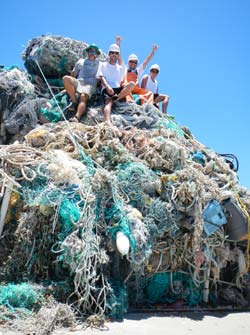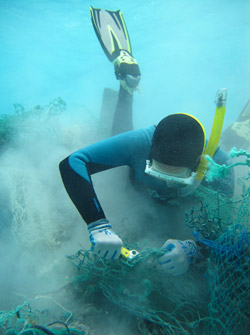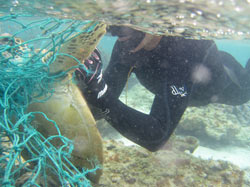
Fifty metric tons of marine debris cleared from Northwestern Hawaiian Islands
The NOAA Ship Oscar Elton Sette arrived back in its homeport of Honolulu on Saturday July 14, 2012 with a shipload of marine debris after a month operating in Papahānaumokuākea Marine National Monument and World Heritage Site.
The team of scientists participated in various activities led by the Pacific Islands Fisheries Science Center of the National Marine Fisheries Service (NMFS), including: staff and equipment deployments at various field camps throughout the NWHI for NMFS, U.S Fish & Wildlife Service and the State of Hawaiʻi; surveys of monk seals and sea turtles at specific locations; and water sampling and deployment of oceanographic equipment in a variety of locations. The team also conducted in-water and shoreline marine debris surveys and removal operations around the northernmost islands and atolls, including Kure Atoll, Midway Atoll, Pearl and Hermes Atoll, Lisianski Island and Laysan Island.
The team collected nearly 50 metric tons of marine debris, approximately half of which was comprised of derelict fishing gear and plastics from Midway Atoll's shallow coral reef environments. Finding this magnitude of trash in an extremely remote region such as this (over a thousand miles from the closest populated area) is a reminder that what we do at home impacts even the most untouched areas on Earth. Marine debris poses a threat to monk seals, sea turtles and other marine life, which can get entangled in discarded fishing nets and other items.
"What surprises us is that after many years of marine debris removal in Papahānaumokuākea and more than 700 metric tons of debris later, we are still collecting a significant amount of derelict fishing gear from the shallow coral reefs and shorelines," said Kyle Koyanagi, marine debris operations manager at NOAA Fisheries' Coral Reef Ecosystem Division and chief scientist for the mission.
The debris, which reached the 224-ft. ship's maximum holding capacity, was stowed on board and brought back to Oʻahu, where it will be used to create electricity through Hawaiʻi's Nets to Energy Program, a public-private partnership. Since 2002, nearly 730 metric tons of derelict nets have been used to create electricity – enough to power nearly 350 Hawaiʻi homes for a year!
NOAA has conducted annual marine debris removal missions in the Monument since 1996 as part of coral restoration efforts. As part of this year's mission, the NOAA team did look for debris from the 2011 tsunami in Japan, however, no debris with an explicit connection to the tsunami was found. Scientists monitored marine debris for radiation in partnership with the Hawaiʻi Department of Health out of an abundance of caution and to gather baseline data from the NWHI.

Participants of marine debris removal activities sit atop a mound of derelict fishing gear collected in Papahānaumokuākea Marine National Monument. Credit: Kyle Koyanagi/NOAA
"While we did not find debris with an obvious connection to last year's tsunami, this mission was a great opportunity to leverage activities that had already been planned and see what we might find," said Carey Morishige, Pacific Islands regional coordinator for NOAA's Marine Debris Program. "It's also an important reminder that marine debris is an everyday problem, especially here in the Pacific."
A portion of the funding for this year's marine debris removal activities was provided as part of the legal settlement collected by NOAA's Damage Assessment, Remediation and Restoration Program from a July 2005 ship grounding at Pearl and Hermes Atoll in the Monument. Additional support was provided by NOAA's Marine Debris Program, NOAA Fisheries' Coral Reef Ecosystem Division, and Papahānaumokuākea Marine National Monument, as well as other partners including U.S. Fish and Wildlife Service and the State of Hawaiʻi. The U.S. Coast Guard has been an important partner in these efforts for many years, as have Hawaiʻi's Nets to Energy partners, including Schnitzer Steel, Covanta Energy, and many others.
For more pictures, click here.

